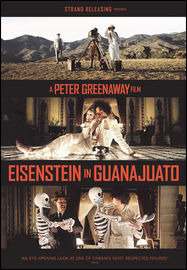(2015, 105 min)
Country: Mexico, Netherlands, Finland, Belgium, France
Director: Peter Greenaway
Studio: Strand Releasing
Language: English
SYNOPSIS: In 1931, at the height of his artistic powers, Soviet filmmaker Sergei Eisenstein travels to Mexico to shoot a new film. Freshly rejected by Hollywood and under increasing pressure to return to Stalinist Russia, Eisenstein arrives at the city of Guanajuato. Chaperoned by his guide Palomino Cañedo, he vulnerably experiences the ties between Eros and Thanatos, sex and death, happy to create their effects in cinema, troubled to suffer them in life. Peter Greenaway's film explores the mind of a creative genius facing his passionate gay desires and fears of love, sex and death through ten passionate days that helped shape the rest of the career of one of the greatest masters of cinema.
REVIEW:
Set in Mexico during the “10 days that shook” Russia’s greatest silent filmmaker, Eisenstein in Guanajuato marks Peter Greenaway’s raucous attempt to capture his all-time cinema idol at his moment of greatest personal discovery and deepest professional frustration — which, the film takes great delight in suggesting, coincided with the loss of his virginity, at age 33, so far from his (still) homophobic homeland. Determined to breathe fresh life into a medium he insists has scarcely evolved in the 90 years since Sergei Eisenstein made “Strike,” Greenaway has wrought an outrageously unconventional and deliriously profane biopic that could take decades to be duly appreciated.
Unspooling like some sort of blasphemous passion play, the film depicts Eisenstein’s symbolic death and subsequent resurrection via an act of gay sex. “Somebody has opened the door to a wet and weepy dirty hurricane,” the Russian gushes not long after his studly Mexican guide, Palomino Canedo (Luis Alberti), pours olive oil down his backside and forcefully mounts him. It’s a scene that makes “Last Tango in Paris” seem tame by comparison, crowned by the sight of Canedo planting a tiny Soviet flag in Eisenstein’s bleeding orifice.
The wily satirist behind “The Cook, the Thief, His Wife and Her Lover” has never shied away from sex or death — the film’s two major themes — though this may be his most flagrant depiction of the former, and one that will severely impede distribution prospects beyond the festival circuit, with very real threats of censorship and boycott in certain regions, particularly those that look upon Eisenstein as a national hero. At the same time, the film could also rekindle interest in a director (Greenaway, not Eisenstein) whose rebellious sensibility has grown increasingly taxing in his late career.
Made by Greenaway at the still-feisty age of 72, this irreverent, yet meticulously researched passion project — arguably the closest to his heart, given his career-long fascination with the dynamic Russian auteur — should catch even cinephiles by surprise. For Eisenstein’s homosexuality is seldom mentioned to those who study “Battleship Potemkin” in film school, while the Mexican chapter is but a footnote in his bio, making whatever sexual adventure he experienced there a speculative codicil to said footnote.
In 1931, Eisenstein drove from California to Guadajuato, after two years of unsuccessfully trying to get a production started in Hollywood. An eccentric and almost clownish figure, the director arrived with a single white suit, red suspenders and wild tumbleweed hair, looking like someone Carrot Top could have played before all the plastic surgery and steroids — not an easy character to cast, especially given the pic’s peculiar stylistic affectation of flashing vintage photographs of its most notable figures whenever their names are mentioned onscreen. Greenaway ultimately found his Sergei in Finnish actor Elmer Back, a highly theatrical performer whose fearless energy is further boosted by d.p. Reinier van Brummelen agitated, wide-angle camerawork.
Armed with the financial support of both Upton Sinclair (bankrolling a feature) and Vladimir Lenin (underwriting his expenses), Eisenstein was immediately smitten with the new country, in which he saw parallels to his communist fatherland (“You had a successful revolution five years before we did”) as well as many fascinating differences (a slapstick scene involving his first-ever shower accustoms us to the sight of his pasty nude torso, embellished with full-frontal closeups, but seems inconsistent with the hygiene practices he must have encountered in L.A.). He was no less impressed by the handsome academic, Canedo, an ostensibly straight scholar of comparative religion, who’d been assigned to show him around.
Most stylistically aggressive in its opening act, the film alternates between color and black-and-white, blending original and vintage footage, frequently dividing the frame into three Abel Gance-esque panels as it crams both exposition and Eisenstein’s effusive personality down our throats. For someone accused of being a communist propagandist, this Eisenstein has more in common with Harpo than Karl Marx, coming across as a self-described caricature, pictured astride an enormous phallic cactus. He went south determined to make his epic “Que viva Mexico” (for which he shot some 250 miles of footage), but was soon derailed by more carnal distractions, presented here in almost carnival-like fashion.
Like Jean Cocteau, Derek Jarman or Ken Russell before him, Greenaway embraces a certain level of in-your-face artificiality when he works, impervious to notions of tackiness and taste. Here, he seeks a language befitting a tragic artistic failure that happily doubled as a personal turning point for the sexually repressed, but in all other ways irrepressible, character. As such, it’s a far livelier film than Greenaway’s 2007 “Nightwatching” (a relatively stodgy re-creation of the circumstances surrounding the creation of a Rembrandt masterpiece), though both reveal how the disciplines of painting and cinema blend in the director’s own work.
Several decades after cinema’s introduction as an art form, it was Eisenstein who effectively demonstrated its nearly boundless potential as an expressionistic poetic medium with his three expressionistic features, “Strike,” “Battleship Potemkin” and “October.” Sync sound had already been introduced by the time he set out to make “Que viva Mexico,” and its arrival posed a setback to many of the innovations of silent cinema, which relied on montage and the synthesis of meaning through purely visual (and frequently abstract) means, rather than the more literal and theatrical chatter that followed.
Eisenstein was an outspoken theoretician on the subject, and here, Greenaway attempts to do justice to that tempestuous, transformative moment in a manner of which his hero might have been proud. But he also crams it full of dialogue (much of it directly quoted from the director’s own writing). For example, Canedo delivers an elaborate monologue over the already overstuffed deflowering scene; in another bravura sequence set in an opulent restaurant, Greenaway uses empty conversation to establish a sense of continuity, stitching together a series of shots taken from different angles and joined by giant, two-story columns.
The big baroque sets — especially the hotel bedroom where the deed goes down — are jaw-droppingly elaborate and fashioned in such a way that screens can be superimposed over walls to reveal supplementary images, including a series of Eisenstein’s pornographic sketches. In other cases, the characters appear to be standing in front of screens, upon which the rooms themselves are artificially projected. It’s a lot to take in, between the aggressive editing, the multilayered visuals (clearly informed by his experiments with 3D technology), and the heavily researched and densely worded screenplay, overflowing with political, philosophical and artistic allusions. As with his unfinished “Que viva Mexico,” Eisenstein almost surely could have edited it into shape, though it’s wonderfully mind-boggling in this unwieldy form as well.
-- Reviewed by Peter Debruge, Variety (www.variety.com)




